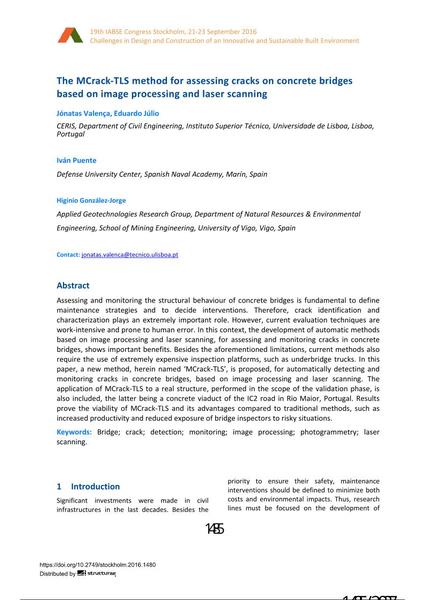The MCrack-TLS method for assessing cracks on concrete bridges based on image processing and laser scanning

|
|
|||||||||||
Bibliografische Angaben
| Autor(en): |
Jónatas Valença
Iván Puente (Defense University Center, Spanish Naval Academy, Marín, Spain) Eduardo Júlio Higinio González-Jorge (Applied Geotechnologies Research Group, Department of Natural Resources & Environmental Engineering, School of Mining Engineering, University of Vigo, Vigo, Spain) |
||||
|---|---|---|---|---|---|
| Medium: | Tagungsbeitrag | ||||
| Sprache(n): | Englisch | ||||
| Tagung: | IABSE Congress: Challenges in Design and Construction of an Innovative and Sustainable Built Environment, Stockholm, Sweden, 21-23 September 2016 | ||||
| Veröffentlicht in: | IABSE Congress Stockholm, 2016 | ||||
|
|||||
| Seite(n): | 1485-1492 | ||||
| Anzahl der Seiten (im PDF): | 8 | ||||
| Jahr: | 2016 | ||||
| DOI: | 10.2749/stockholm.2016.1480 | ||||
| Abstrakt: |
Assessing and monitoring the structural behaviour of concrete bridges is fundamental to define maintenance strategies and to decide interventions. Therefore, crack identification and characterization plays an extremely important role. However, current evaluation techniques are work-intensive and prone to human error. In this context, the development of automatic methods based on image processing and laser scanning, for assessing and monitoring cracks in concrete bridges, shows important benefits. Besides the aforementioned limitations, current methods also require the use of extremely expensive inspection platforms, such as underbridge trucks. In this paper, a new method, herein named ‘MCrack-TLS’, is proposed, for automatically detecting and monitoring cracks in concrete bridges, based on image processing and laser scanning. The application of MCrack-TLS to a real structure, performed in the scope of the validation phase, is also included, the latter being a concrete viaduct of the IC2 road in Rio Maior, Portugal. Results prove the viability of MCrack-TLS and its advantages compared to traditional methods, such as increased productivity and reduced exposure of bridge inspectors to risky situations. |
||||
| Stichwörter: |
Brücke Riß Laserscanning Bildverarbeitung Photogrammetrie Monitoring
|
||||

